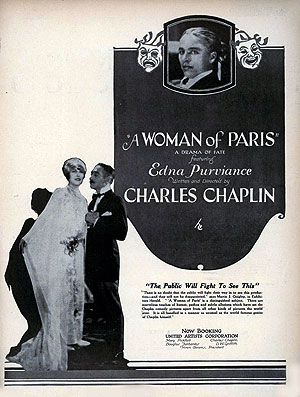
A Woman Of Paris

A WOMAN OF PARIS (MOVIE)
Charlie Chaplin Productions
Original release: September 26th, 1923
Running time: 93 minutes
Writer and director: Charles Chaplin
Cast: Edna Purviance, Adoplhe Menjou, Carl Miller
Most people will have, at some point, found themselves in a situation where they’re confronted with two romantic choices. In real life, the choice tends to be of choosing to be with someone else, or not to. In the movies of course, this is different.
How many times have we seen the guy or gal have to make the difficult choice between the ‘cool’ or ‘dangerous’ hunk/bombshell and the slightly more plain – but in reality no less sexy – friend who actually happens to have genuine feelings for said guy or gal.
Even the most cursory glance back gives us a plethora of examples of characters having to choose between two love interests with varying levels of success; from Casablanca (1942), through to Dirty Rotten Scoundrels (1988).

This is an age old quandary in which to place the protagonist and allows for filmmakers to show their own philosophy, morality or world view as they decide who things end up.
Were you to be told that Charlie Chaplin made a film with this very set up, and given Chaplin’s propensity for lashings of syrup with his comedies, you might think you know full well how this film will end. A Woman in Paris is no normal Chaplin film though and there are two reasons why. Firstly it is a drama, not a comedy; secondly, it doesn’t star Chaplin.
These things were both pretty shocking at the time of the film’s release and Chaplin went as far as handing out flyers to those in the queue to see the film and placing the following announcement at the beginning of the film, just to make sure everyone was on the same page:
Despite the warnings, audiences didn’t receive it well and A Woman of Paris became Chaplin’s first failure and hit him very hard.
The picture sees Marie St. Clair (Edna Purviance) running away from her authoritarian father to Paris and living the high life on the arm of well-to-do socialite Pierre Revel (Adoplhe Menjou). He treats her well but intends to keep her as a mistress even though he’s betrothed to another.
When she bumps into her childhood sweetheart, Jean (Carl Miller), a struggling artist, she’s torn between the comfort and lack of love with Pierre, and the rekindled passion but a drop in status that would come with Jean.  A tough choice I’m sure you’ll agree.
A tough choice I’m sure you’ll agree.
The setup may be a time honoured dilemma but in fact the film itself broke the mould completely. Gone were the extravagant gestures and overblown facial expressions that were prevalent in silent cinema. What Chaplin extracted from his cast in A Woman of Paris was a very early example of realism in cinema.
Although not perhaps as subdued as we expect today, the performances are extremely low-key and realistic for the time and the characters have a lot more depth to them than we might expect as well.
Marie is torn between the two men: there’s no dastardly villain kidnapping the damsel and needing to be rescued (a la Harold Lloyd’s Girl Shy) this is a choice Marie is confronted with and her indecision is portrayed wonderfully by Purviance.
The two men she must choose between were also not atypical for the time; the villain is genial, handsome and charming whilst the hero is weak willed. Dominated by his interfering mother, he promises not to marry Marie even after he’s already proposed to her. Of course she overhears this, complicating matters further.

The portrayal of the mother was also something ahead of its time; gone was the caring bosom mothers were normally portrayed as. Jean’s mother and Marie’s father are portrayed as real people who can be overbearing and ultimately it’s the parents of the lovers who set them on the road that could well lead to tragedy.
A Woman of Paris is easily the kind of film that you could miss when going through Chaplin’s back catalogue: it’s a drama; it didn’t do very well at the box office and it doesn’t even star the man himself (apart from a cameo).
If you take the time to have a look though, you’ll find a film that helped to change the face of cinema and one which deserves more limelight than it gets. Not only does it give us naturalistic performances but also an early example of the great cinematic dilemma, and you may be surprised how it all works out.

Ben Nicholson
Ben has had a keen love of moving images since his childhood but after leaving school he fell truly in love with films. His passion manifests itself in his consumption of movies (watching films from all around the globe and from any period of the medium’s history with equal gusto), the enjoyment he derives from reading, talking and writing about cinema and being behind the camera himself having completed his first co-directed short film in mid-2011.
His favourite films include things as diverse as The Third Man, In The Mood For Love, Badlands, 3 Iron, Casablanca, Ran and Grizzly Man to name but a few.
Ben has his own film site, ACHILLES AND THE TORTOISE, and you can follow him on Twitter @BRNicholson.
© 2022 STATIC MASS EMPORIUM . All Rights Reserved. Powered by METATEMPUS | creative.timeless.personal. | DISCLAIMER, TERMS & CONDITIONS
HOME | ABOUT | CONTACT | TWITTER | GOOGLE+ | FACEBOOK | TUMBLR | YOUTUBE | RSS FEED
CINEMA REVIEWS | BLU-RAY & DVD | THE EMPORIUM | DOCUMENTARIES | WORLD CINEMA | CULT MOVIES | INDIAN CINEMA | EARLY CINEMA
MOVIE CLASSICS | DECONSTRUCTING CINEMA | SOUNDTRACKS | INTERVIEWS | THE DIRECTOR’S CHAIR | JAPANESE CINEMA





